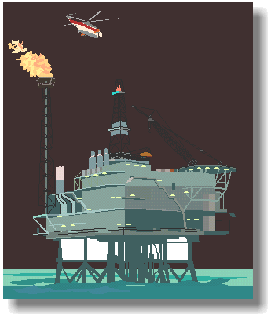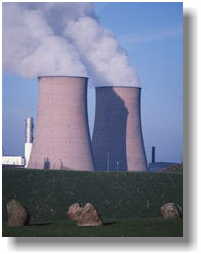![]()
![]()
![]()
![]()
![]()
![]()
![]()
![]()
![]()
![]()
![]()
This site is designed to be viewed on an
800 x 600 screen,
with level 4+ browsers.
Created
by Andy Dervill
Science teacher at
Broadoak Community School England
Web site www.darvill.clara.net
Coal, Oil and Gas are called "Fossil Fuels"
Introduction How it works More details Advantages Disadvantages Is it renewable?
![]()
Introduction
| Coal, oil and gas are called "fossil fuels" because they have been formed from the organic remains of prehistoric plants and animals. Find out more about how they formed at www.energyquest.ca.gov/story/chapter08.html At the time this page was written, they provided around 66% of the world's electrical power, and 95% of the world's total energy demands (including heating, transport, electricity generation and other uses). |
 |
![]()
How it works:
Coal is crushed to a fine dust and burnt. Oil and gas can be burnt directly.

![]()
More Details:
| Coal provides around 28% of our energy, and oil provides 40%. Mind you, this figure is bound to have changed since this page was written, so check the figures if you want to quote them. Burning coal produces sulphur dioxide, an acidic gas that contributes to the formation of acid rain. This can be largely avoided using "flue gas desulphurisation" to clean up the gases before they are released into the atmosphere. This method uses limestone, and produces gypsum for the building industry as a by-product. However, it uses a lot of limestone. More details on 'clean coal technology' from BBC News web site... Crude oil (called "petroleum") is easier to get out of the ground than coal, as it can flow along pipes. This also makes it cheaper to transport. |
 |
| Natural
gas provides around 20% of the world's consumption of energy,
and as well as being burnt in power stations, is used by many
people to heat their homes. Other
fossil fuels are being investigated, such as bituminous sands
and oil shale. The difficulty is that they need expensive processing
before we can use them; however Canada has large reserves of 'tar
sands' , which makes it economic for them to produce a great deal
of energy this way. Find out more at www.eia.doe.gov/emeu/cabs/canada.html |
| The steam that has passed through the power station's turbines has to be cooled, to condense it back into water before it can be pumped round again. This is what happens in the huge "cooling towers" seen at power stations. Some power stations are built on the coast, so they can use sea water to cool the steam instead. However, this warms the sea and can affect the environment, although the fish seem to like it. |
 |
| Find out about Drax Coal-fired power station in Selby, UK |
![]()
Advantages
- Very large
amounts of electricity can be generated in one place using coal,
fairly cheaply.
- Transporting
oil and gas to the power stations is easy.
- Gas-fired
power stations are very efficient.
- A fossil-fuelled power station can be built almost anywhere, so long as you can get large quantities of fuel to it. Didcot power station, in Oxfordshire, has a dedicated rail link to supply the coal.
![]()
Disadvantages
-
Basically, the main drawback of fossil fuels is pollution.
Burning any fossil fuel produces carbon dioxide, which contributes to the "greenhouse effect", warming the Earth.
-
Burning coal produces more carbon dioxide than burning oil or gas.
It also produces sulphur dioxide, a gas that contributes to acid rain. We can reduce this before releasing the waste gases into the atmosphere.
More details on 'clean coal technology' from BBC News web site...
-
Mining coal can be difficult and dangerous. Strip mining destroys large areas of the landscape.
-
Coal-fired power stations need huge amounts of fuel, which means train-loads of coal almost constantly. In order to cope with changing demands for power, the station needs reserves.
This means covering a large area of countryside next to the power station with piles of coal.
![]()
Is it renewable?
Fossil
fuels are not a renewable
energy resource.
Once we've burned them all, there isn't any more, and our consumption
of fossil fuels has nearly doubled every 20 years since 1900.
This is a particular problem for oil, because we also use it to make
plastics and many other products.
Ok, you could argue that fossil fuels are renewable because more coal seams and oil fields will be formed if we wait long enough. However that means waiting for many millions of years. That's a long time - we'd have to wait around for longer than the time that humans have existed so far! As far as we today are concerned, we're using it up very fast and it hardly gets replaced at all - so by any sensible human definition fossil fuels are not renewable.